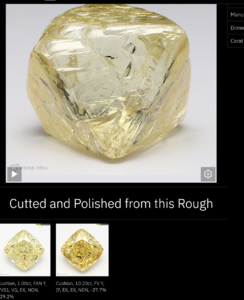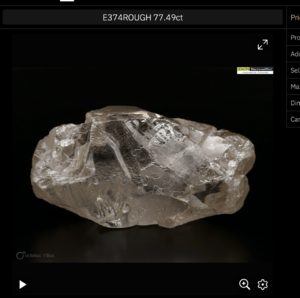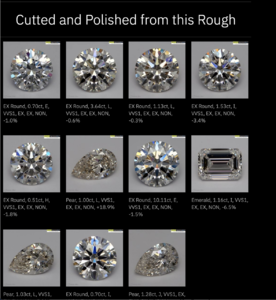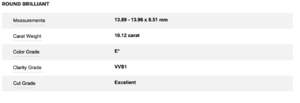- Joined
- Apr 3, 2004
- Messages
- 33,852
So on a MRB you can have a D color crown and a intense yellow color pavil?Rough can be different colours across a piece of it - Yoram has posted Instagram photos of a cut diamond with colour banding, which must mean rough is more than one colour

More likely brown it would be unlikely for a diamond rough to have partial nitrogen for yellow unless it was 2 crystals that grew together at different times when conditions changed.So on a MRB you can have a D color crown and a intense yellow color pavil?
Pics!!I'm going to say yes because I have a yellow Argyle diamond here that is tiny that is multi coloured ie it's not one yellow it's like 3 or 4 different shades of yellow across the face of the stone.
Didn't poshmommy get a beautiful custom cut diamond by Victor Canera, where the initial rough resulted in a I and J (poshmommys stone) colored diamond?
Sorry for coming to this thread a little late. I will try to explain it as simply as possible. There are actually two aspects at play, independently, and when one thinks about the second aspect, one could wonder whether lab-grading of color, as it exists, makes logical sense.
Aspect 1 is color-zoning. This exists and can have various causes. But let's just agree to the simple fact: tint is not necessarily evenly distributed across a rough diamond.
Aspect 2 is possibly more interesting, as it shows a relationship of color with size and cut-quality.
This often is the case in a nice rough crystal, lending itself two two polished diamonds, one clearly bigger than the other. Just imagine a 1.20 Ct. and a 0.45 Ct.
Now, suppose both, for sake of simplicity, to be cut in the same cut-quality and in round brilliant.
We generally state that the color of diamonds is graded from the side because this allows to observe the true body-color. But is that reasoning fully correct? In diamonds of a smaller size, the light goes through less diamond material before exiting. The result: with the material having the same color, a smaller diamond cut from that material can be graded a higher color than a bigger diamond from the same material.
Hope this helps.
Live long,
Wow. That blue radiant is quite a stone.https://cutwise.com/rough/13868
D color 2.00ct and Intense Blue 6.60ct from same rough!
it was amazing sample.
Wow. That blue radiant is quite a stone.



Yellow 10 Fancy Vivid ... and 1ct Fancy yellow ... from same rough. In this case the rough had not any color zoning and only difference in the size crated the difference in color
Thank you very much indeed for the treat, @Serg !
___
NTS
This tells of how wide the FVY range is & what it means being small & vivid!
https://cutwise.com/rough/23096?sp=2
11 polished diamonds from E to L from one rough.
You may see here how color grade depends from size and cut of polished diamonds( the rough had color zoning also)
WOW! This is fascinating, amazing, and so educational. Thank you, Serg, very much.
https://cutwise.com/rough/23096?sp=2
11 polished diamonds from E to L from one rough.
You may see here how color grade depends from size and cut of polished diamonds( the rough had color zoning also)


